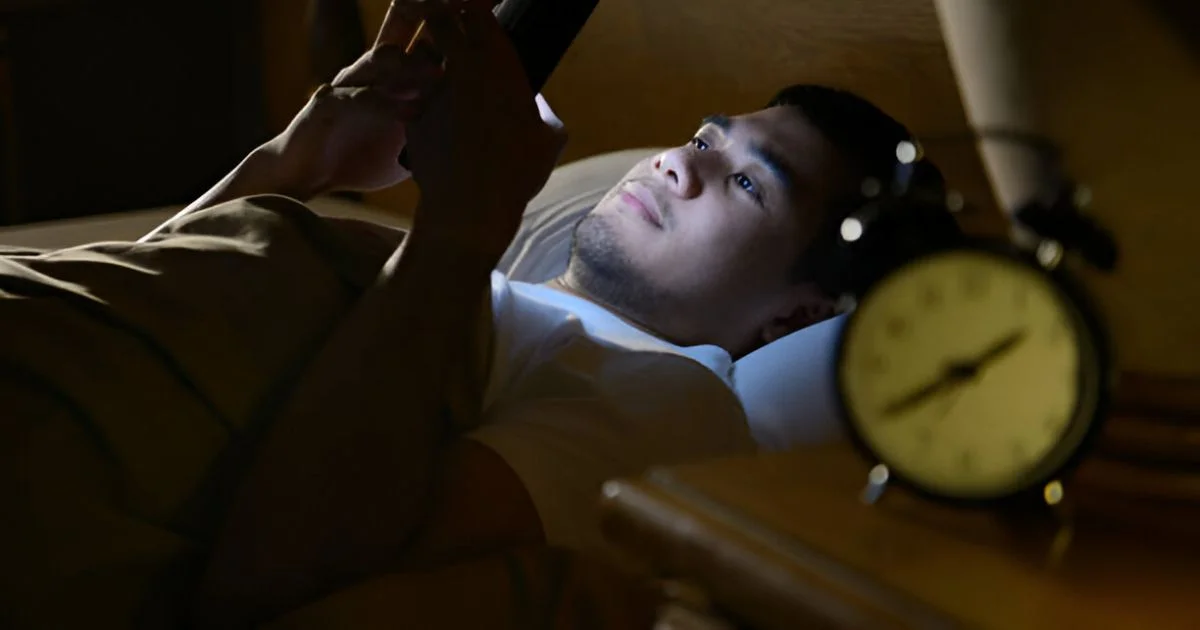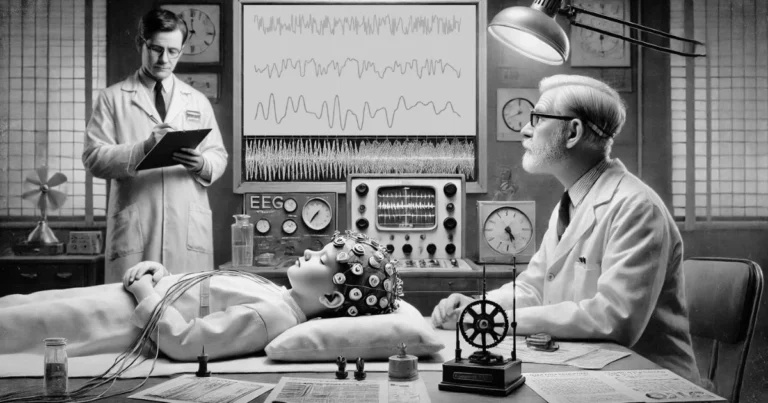Sleep vs. Screens: The silent battle for your brain
Midnight. In the stillness of a darkened room, the cold glow of a smartphone draws the gaze of a tired eye. As eyelids grow heavy, fingers continue their silent dance across the screen, responding to notifications. Once, nighttime signaled rest and renewal. Today, it’s interrupted, hijacked by technology. The blue light emitted from our screens disrupts the body’s natural sleep mechanisms. Recent studies, including one published in the Journal of Clinical Endocrinology & Metabolism (2023), reveal that after just 60 minutes of screen exposure, melatonin levels, the hormone that regulates sleep, drop by 40%. At the same time, attention-capturing algorithms overstimulate the brain’s dopaminergic circuits.
As neuroscientist Matthew Walker, author of Why We Sleep (2018), warns, “Every minute stolen from sleep is a debt the body will repay in dark currency: degraded health, dulled mind, shortened life.” This collision between biology and digital behavior blurs the line between wakefulness and rest, raising a critical question: how can we reclaim the night and restore its vital role in preserving our health and balance?
Hijacked chronobiology: Blue light as a disruptor of the internal clock
Our bodies operate on a precise rhythm: a 24-hour cycle regulated by light. At dawn, cortisol and dopamine kick-start our alertness. At dusk, melatonin takes over, guiding the body toward sleep. This hormonal ballet, refined over millennia, depends on a delicate balance between light and darkness.
However, screens have disrupted this ancient system. Their blue light, wavelengths around 450 nanometers, mimics daylight and suppresses melatonin production by up to 40% within an hour, effectively turning our evenings into artificial daytimes. Charles Czeisler, chronobiologist at Harvard, summed it up in Nature (2022): “Artificial light has been the number one disruptor of the internal clock since the invention of the light bulb.”
But smartphones, tablets, and computers don’t merely emit light, they send the brain a misleading message: “Stay awake.” Each notification, each scroll, reinforces this state of alert. The result? A growing gap between our biological clock, which calls for rest, and our social habits, extended by digital dependency. These constant disturbances have measurable effects. Reading on a screen before bed delays sleep onset by an average of 90 minutes, compared to 30 minutes for a printed book. This so-called “domestic jetlag” isn’t just a metaphor. It’s quantifiable: shortened sleep cycles, reduced deep sleep, and diminished daytime alertness. Worse, it interferes with brain regeneration, memory consolidation, and the removal of neurotoxins, processes that only occur in uninterrupted darkness.
Fragmented sleep can impair cognitive function as severely as a blood alcohol level of 0.5 g/L (Rebecca Robbins et al., Sleep Health, 2021). Blue light isn’t a harmless annoyance, it’s a biochemical saboteur. By blocking melatonin and desynchronizing circadian rhythms, it imposes a chronic state of imbalance with real-world consequences: disrupted sleep, impaired cognition, and heightened risk of metabolic disorders. The science is clear, and the data is compelling, it’s time to recognize screens for what they are: endocrine-disrupting sources of artificial light.
Nocturnal micro-aggressions: the invisible erosion of rest
Through the breakdown of deep sleep, the disorganization of REM sleep, and the illusion of restful slumber, screens are undermining our capacity for nighttime recovery.
Deep sleep, critical for physical repair and cellular regeneration, is especially vulnerable. Every vibration or flicker of light triggers a micro-arousal. These brief but repeated interruptions fragment the sleep cycle, rendering it ineffective. Without long, uninterrupted stretches of sleep, the body accrues a sleep debt: diminished focus, faulty memory, and sluggish alertness. Research shows that fragmented sleep can be just as damaging as partial sleep deprivation.
REM sleep, essential for emotional regulation and learning, also suffers. Digital intrusions disrupt the amygdala’s nighttime processing, interfering with emotional reset. Dreams, truncated and disjointed, lose their cathartic power. The consequences? Heightened irritability, lowered stress resilience, and stunted creativity. A 2023 University of California study linked such disruptions to a 30% decrease in problem-solving abilities.
Simply getting eight hours of sleep is no longer enough. When sleep is broken, its restorative effects are compromised. It’s a cruel paradox: long nights that leave us drained. Epidemiological data paints a grim picture: fragmented sleep doubles the risk of metabolic diseases such as type 2 diabetes and obesity, and reduces immune response by 40% over six months (The Lancet, 2022).
Screens don’t just steal our time, they erode the very fabric of rest. By attacking the brain’s most vital recovery phases, they produce a toxic fatigue, both mental and physical. Their danger lies in the invisibility of the damage: micro-awakenings that go unnoticed but accumulate into significant health threats. The scientific consensus is urgent and clear: maintaining sleep continuity is a biological imperative, and it demands an active defense against digital intrusion.
Neurohacked: the algorithmic war on your brain and sleep
The human brain, targeted by increasingly sophisticated manipulation, is bombarded each night with stimuli engineered for addiction. Dopamine, the neurotransmitter of reward, is hijacked. In the dark, screens trigger artificial dopamine surges, likes, messages, notifications, all mimicking the thrill of slot machines. Algorithms designed to maximize engagement exploit this vulnerability, trapping the brain in a loop of compulsive alertness.
This chemical manipulation is reinforced by persuasive design, an entire field of behavioral engineering. As Nir Eyal writes in Indistractable (2019): “Screens don’t steal our time, they exploit our inability to resist instant gratification.” The digital giants understand this perfectly. Auto-play, endless feeds, infinite scrolls, these features are built to override our willpower. Their tool of choice? Captology, the science of persuasive technology, developed by B.J. Fogg. These interfaces prey on FOMO (Fear of Missing Out), compulsive curiosity, and the craving for instant reward. Each scroll is a gamble: what if the next video, the next post, holds the payoff?
This cycle creates the illusion of relaxation, while in reality, screens keep the brain on high alert. “I’m just winding down before bed”, a common refrain that hides a damaging truth. Streaming shows, scrolling through social media, or gaming, all perceived as unwinding activities, activate the prefrontal cortex, inhibit melatonin through blue light exposure, and stimulate the amygdala and hypothalamus. A Stanford study (2023) confirms that 78% of users feel “less rested” after an evening of screen time, even when logging a full eight hours of sleep.
Digital platforms have waged war on the brain. Their strategy? A three-pronged attack: hijack dopamine pathways, lock attention with addictive design, and disguise hyperstimulation as relaxation. The scientific data leaves no doubt: a 2023 Addiction Biology study shows that compulsive social media use alters connectivity in the nucleus accumbens, the brain’s reward center, confirming a biochemical hijacking. This systematic assault disrupts sleep architecture, undermines neuronal recovery, and fuels a cycle of dependency. This isn’t a side effect, it’s the business model. Every minute of stolen sleep generates ad revenue.
The counterattack must begin with radical awareness: disconnecting is not deprivation. It’s biological resistance.
Growing up sleep-deprived: how screens endanger developing minds
The adolescent brain, still developing until around age 25, is ill-equipped to resist digital manipulation. The prefrontal cortex, responsible for impulse control and judgment, is not yet fully formed. Platforms like Snapchat, TikTok, and online games exploit adolescent neuroplasticity, reinforcing circuits of impulsivity and instant gratification.
The consequences are serious: fragmented sleep, deteriorated attention, and chronic anxiety. A 2023 INSERM study by Jean Twenge and W. Keith Campbell found that teens with excessive screen exposure are three times more likely to experience depressive symptoms before age 18. More troubling still, what appears to be a source of comfort becomes a cognitive trap.
At home, screens are often used as pacifiers, to soothe tantrums, fill silences, or replace real presence. But this “digital babysitter” costs far more than time. It stunts emotional development, diminishing a child’s ability to manage conflict, tolerate boredom, and regulate emotions. This leads to what psychiatrists now call “digital emotional regulation disorder.” While these mechanisms often go unnoticed, science is measuring their consequences with chilling precision.
The numbers speak for themselves. Among 12–17-year-olds, each additional hour of daily screen time reduces academic performance by 8% (PISA, 2022). Children’s melatonin suppression occurs twice as fast as in adults (JAMA Pediatrics, 2021). Disruption of deep sleep, essential for physical growth, delays musculoskeletal development. Pediatricians are also noting a sharp rise in early puberty, linked to circadian rhythm disturbances.
In short, today’s youth are caught between a vulnerable brain and a predatory digital ecosystem. Screens are undermining not just their sleep, but their cognitive and biological development. The data is damning: this generation will sleep less, learn less, and suffer more. Protecting minors from addictive designs is not optional, it’s an ethical mandate. We need binding regulations, meaningful digital education, and a societal reckoning with screen use in childhood. Every minute stolen from a teen’s sleep is a theft from their future.
Toward a sleep ecology: Resisting without withdrawing
The war on sleep has been declared, but the tools to fight back are within reach. Blue-light filters (which reduce melatonin inhibition by up to 65%), digital curfews two hours before bed, and analog bedtime rituals, like reading print books, journaling, or gentle stretching, are not luxuries. They are the new pillars of wellness. According to a 2022 study in Sleep Health, people who adopt these habits gain an average of 42 additional minutes of restorative sleep per night, a measurable, reproducible benefit.
However, practical strategies only make sense when anchored in a deeper truth: sleep is not a pause or a waste of time. It is a fundamental act, on par with breathing and eating. To restore its regenerative power, we must re-sanctify the night. Wi-Fi-free zones, routers shut off by 10 p.m., and banning smartphones from bedrooms, these are ways to reclaim the nighttime environment. A warm infusion, a book read by soft light, or instrumental music, these become new gateways into peaceful sleep, far from algorithmic noise.
Still, this personal reconquest is not enough. The quality of sleep cannot rest solely on individual will. It demands systemic change, with three pillars:
● Limit digital stimulation after 9 p.m., as recommended by the WHO.
● Introduce screen education early, embedding it into school curricula.
● Require platforms to implement “night modes”: lower brightness, disable addictive features, and discourage compulsive engagement.
This is not utopia, it’s necessity. Reconciling technology with sleep means preserving the biological sanctuary of the night. The science is overwhelming. The tools exist. Now it’s time to act. Parents, educators, developers, lawmakers, everyone has a role. Every screen turned off in time is a victory against fatigue, mental fog, and chronic imbalance.
I disconnect, therefore I am: Reinventing our nights to reclaim our humanity
In the stillness of a screen-free night, when the digital world fades, a sacred space reemerges, that of true rest. This is not retreat, it is return. A return to the essential. A reclaiming of our lost intimacy with ourselves. By choosing to disconnect, we reaffirm a fundamental right: to restore, to find balance, to protect our health.
This battle is personal, yes, but it is also collective. Parents, educators, policymakers, and citizens must come together to create new rituals of disconnection, to carve out interruption-free spaces, and to teach responsible use. Every small gesture becomes a building block for a future where rest is no longer sacrificed to immediacy.
“I disconnect, therefore I am.”
For in returning the night to its rightful place, we choose to live fully, to make space for real connections: those born from silence, from heartbeat, and from the deep, sacred rhythms of restorative sleep. As Henry David Thoreau once wrote:
“Sleep is the most innocent delight there is.”
References
Czeisler, C.A. (2022). Artificial Light and Circadian Disruption. Nature.
Eyal, N. (2019). Indistractable: How to Control Your Attention. Bloomsbury.
Fogg, B.J. (2003). Persuasive Technology. Morgan Kaufmann.
McCoy JG, Strecker RE. The cognitive cost of sleep lost. Neurobiol Learn Mem. 2011 Nov;96(4):564-82.
Thoreau, H.D. (1854). Walden, ou la vie dans les bois.
Twenge JM, Campbell WK. Associations between screen time and lower psychological well-being among children and adolescents: Evidence from a population-based study. Prev Med Rep. 2018 Oct 18;12:271-283.
Twenge, J.M. & Campbell, W.K. (2023). Screen Time and Adolescent Mental Health. INSERM.
Walker, M. (2018). Pourquoi nous dormons. Éditions La Découverte.

Ahmed El Bounjaimi
Copywriter-Content Designer
Master’s in Organizational Communication, Hassan II University
Bachelor’s in Philosophy of Communication and Public Spheres, Hassan II University







